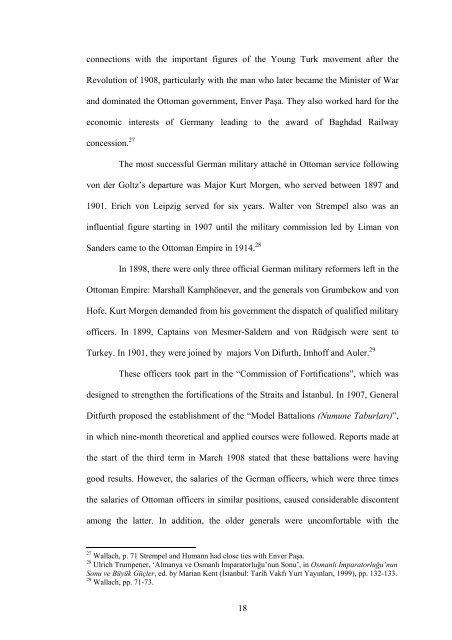the beginnings of ottoman-german partnership - Bilkent University
the beginnings of ottoman-german partnership - Bilkent University
the beginnings of ottoman-german partnership - Bilkent University
You also want an ePaper? Increase the reach of your titles
YUMPU automatically turns print PDFs into web optimized ePapers that Google loves.
connections with <strong>the</strong> important figures <strong>of</strong> <strong>the</strong> Young Turk movement after <strong>the</strong><br />
Revolution <strong>of</strong> 1908, particularly with <strong>the</strong> man who later became <strong>the</strong> Minister <strong>of</strong> War<br />
and dominated <strong>the</strong> Ottoman government, Enver Paşa. They also worked hard for <strong>the</strong><br />
economic interests <strong>of</strong> Germany leading to <strong>the</strong> award <strong>of</strong> Baghdad Railway<br />
concession. 27<br />
The most successful German military attaché in Ottoman service following<br />
von der Goltz’s departure was Major Kurt Morgen, who served between 1897 and<br />
1901. Erich von Leipzig served for six years. Walter von Strempel also was an<br />
influential figure starting in 1907 until <strong>the</strong> military commission led by Liman von<br />
Sanders came to <strong>the</strong> Ottoman Empire in 1914. 28<br />
In 1898, <strong>the</strong>re were only three <strong>of</strong>ficial German military reformers left in <strong>the</strong><br />
Ottoman Empire: Marshall Kamphönever, and <strong>the</strong> generals von Grumbckow and von<br />
H<strong>of</strong>e. Kurt Morgen demanded from his government <strong>the</strong> dispatch <strong>of</strong> qualified military<br />
<strong>of</strong>ficers. In 1899, Captains von Mesmer-Saldern and von Rüdgisch were sent to<br />
Turkey. In 1901, <strong>the</strong>y were joined by majors Von Difurth, Imh<strong>of</strong>f and Auler. 29<br />
These <strong>of</strong>ficers took part in <strong>the</strong> “Commission <strong>of</strong> Fortifications”, which was<br />
designed to streng<strong>the</strong>n <strong>the</strong> fortifications <strong>of</strong> <strong>the</strong> Straits and İstanbul. In 1907, General<br />
Ditfurth proposed <strong>the</strong> establishment <strong>of</strong> <strong>the</strong> “Model Battalions (Numune Taburları)”,<br />
in which nine-month <strong>the</strong>oretical and applied courses were followed. Reports made at<br />
<strong>the</strong> start <strong>of</strong> <strong>the</strong> third term in March 1908 stated that <strong>the</strong>se battalions were having<br />
good results. However, <strong>the</strong> salaries <strong>of</strong> <strong>the</strong> German <strong>of</strong>ficers, which were three times<br />
<strong>the</strong> salaries <strong>of</strong> Ottoman <strong>of</strong>ficers in similar positions, caused considerable discontent<br />
among <strong>the</strong> latter. In addition, <strong>the</strong> older generals were uncomfortable with <strong>the</strong><br />
27 Wallach, p. 71 Strempel and Humann had close ties with Enver Paşa.<br />
28 Ulrich Trumpener, ‘Almanya ve Osmanlı İmparatorluğu’nun Sonu’, in Osmanlı İmparatorluğu’nun<br />
Sonu ve Büyük Güçler, ed. by Marian Kent (İstanbul: Tarih Vakfı Yurt Yayınları, 1999), pp. 132-133.<br />
29 Wallach, pp. 71-73.<br />
18
















